Własna strona umożliwia korzystanie z innego układu niż reszta twojej witryny internetowej. Wiele witryn WordPress korzysta z własnych układów stron dla stron sprzedaży, stron docelowych, stron webinarów i innych.
Przez lata stworzyliśmy wiele niestandardowych stron na WPBeginner do różnych celów. Używaliśmy ich do pokazywania różnych ofert na wtyczki i usługi hostingowe, oferowania usług Pro, aby pomóc użytkownikom w korzystaniu z WordPressa, wyświetlania różnych produktów i nie tylko.
Z naszego doświadczenia wynika, że istnieje wiele sposobów tworzenia niestandardowych stron. W niektórych naszych projektach korzystaliśmy z kreatorów stron, takich jak SeedProd. Poza tym można również użyć edytora bloków lub pełnych edytorów witryn, aby dodać niestandardowe strony do swojej witryny.
W tym artykule pokażemy, jak łatwo utworzyć własną stronę w WordPress.
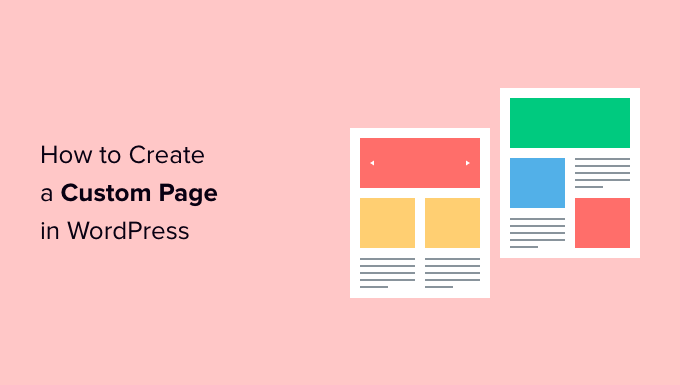
Dlaczego warto utworzyć własną stronę w WordPress?
Za każdym razem, gdy tworzysz nową stronę, motyw WordPress kontroluje jej wygląd za pomocą pliku szablonu.
Szablon page.php ma wpływ na wszystkie pojedyncze strony tworzone w WordPressie. Możesz jednak nie chcieć używać tego samego projektu za każdym razem.
Strony docelowe często mają inną zawartość niż zwykłe strony, takie jak duży obraz bohatera lub wezwanie do działania (CTA). Oznacza to, że często wyglądają zupełnie inaczej niż reszta witryny.
Jednak próba stworzenia unikatowych projektów przy użyciu standardowego szablonu strony może zająć dużo czasu. Jesteś również ograniczony przez szablon page.php i możesz nie być w stanie stworzyć dokładnie takiego projektu, jaki chcesz. Może to utrudnić uzyskanie dobrych wyników. Na przykład, jeśli tworzysz stronę sprzedażową, możesz nie uzyskać wielu konwersji z powodu złego projektu strony.
Mając to na uwadze, zobaczmy, jak utworzyć własną stronę w WordPressie, z dokładnym projektem, układem i treścią, którą chcesz. Skorzystaj z poniższych odnośników, aby przejść bezpośrednio do wybranej metody.
- Method 1. How to Create a Custom Page in WordPress Using the Block Editor (No Plugin Required)
- Method 2. How to Create a Custom Page Using the Full-Site Editor (Block-Based Themes Only)
- Method 3. Create a Custom Page in WordPress using SeedProd (Recommended)
- Method 4. Using Thrive Architect to Create a Custom Page in WordPress
Metoda 1. Jak utworzyć własną stronę w WordPressie za pomocą edytora bloków (bez wtyczki)?
Edytor bloków ułatwia projektowanie własnych szablonów przy użyciu narzędzi, które już znasz.
Jest to dobry wybór, jeśli planujesz ponownie wykorzystać ten sam projekt na wielu stronach, ponieważ możesz po prostu zastosować ten sam szablon. Jeśli chcesz stworzyć całkowicie unikatowy projekt, inną opcją jest utworzenie strony w normalny sposób, a następnie edytowanie jej układu za pomocą edytora całej witryny, który omówimy w Metodzie 2.
Należy tylko pamiętać, że metody te działają tylko z motywami opartymi na blokach, takimi jak ThemeIsle Hestia Pro lub Twenty Twenty-Three. Jeśli nie posiadasz motywu blokowego, zalecamy skorzystanie z kreatora stron.
Aby rozpocząć, wystarczy otworzyć dowolną stronę lub wpis. Następnie wybierz kartę “Strona” w menu po prawej stronie i kliknij tekst obok “Szablon”.
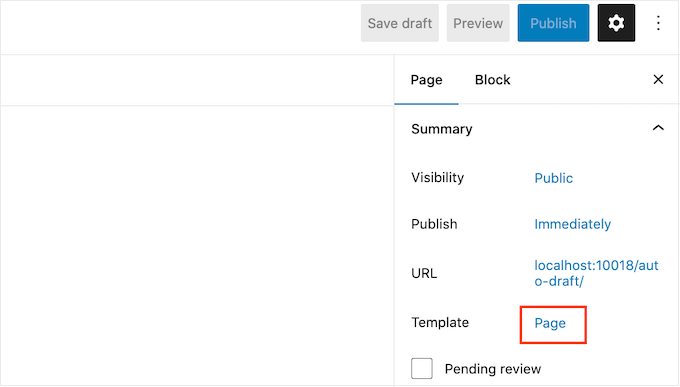
Opcje, które zobaczysz, mogą się różnić w zależności od twojego motywu WordPress, ale tekst będzie zazwyczaj pokazywał “Stronę”, “Domyślny szablon” lub podobny.
W wyświetlonym oknie kliknij ikonkę “Dodaj szablon”.
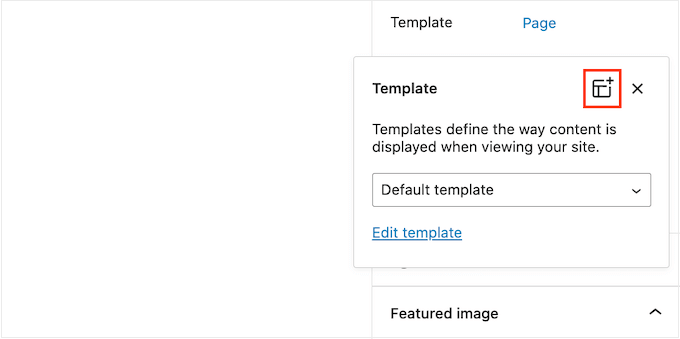
W wyświetlonym oknie wpisz rodzaj nazwy twojego szablonu, a następnie kliknij przycisk “Utwórz”.
Nazwa jest tylko dla twojego odniesienia, więc możesz użyć czegokolwiek chcesz.
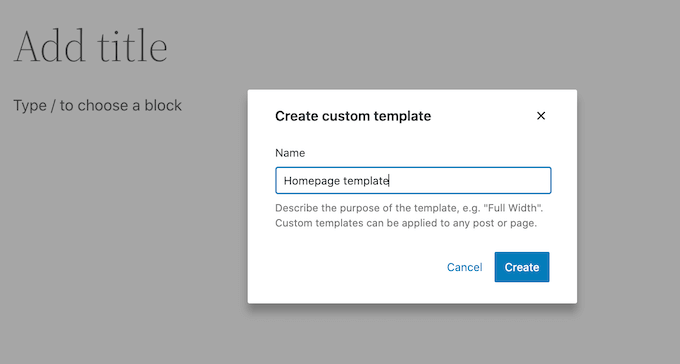
Spowoduje to uruchomienie edytora szablonów, który działa podobnie do edytora treści WordPress.
Aby dodać bloki do własnego projektu strony, wystarczy kliknąć niebieski przycisk “+”. Następnie możesz przeciągnąć i upuścić, aby dodać bloki.
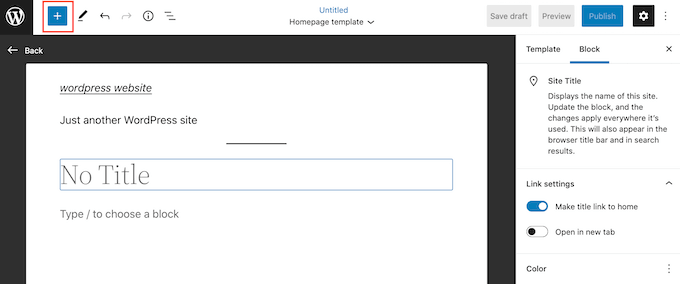
Możesz dodać treść do bloku lub zmienić jego formatowanie za pomocą znanych narzędzi do edycji wpisów WordPress. Na przykład, możesz wpisać rodzaj tekstu do bloku “Nagłówek”, zastosować pogrubienie lub zmienić tekst z H2 na H3.
Własną stronę można również utworzyć przy użyciu wzorców. Wzorce to kolekcje bloków, które są często używane razem, takie jak lista wydarzeń, obrazek z podpisem lub tabela cen.
Widoczne wzorce będą się różnić w zależności od twojego motywu WordPress, ale możesz zobaczyć, które wzorce są dostępne, klikając kartę “Wzorce”.
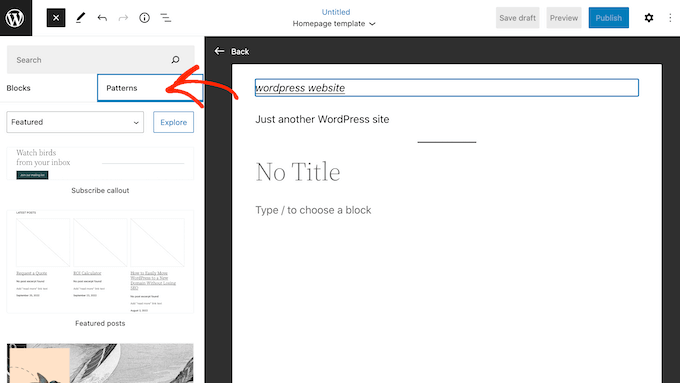
Możesz przeciągnąć i upuścić wzorzec bloku na twój układ lub kliknąć na wzorzec, aby dodać go na dole szablonu. Gdy będziesz zadowolony z wyglądu szablonu, kliknij przycisk “Opublikuj”, a następnie “Zapisz”.
Możesz teraz zastosować ten szablon do dowolnej strony. Wystarczy otworzyć stronę w edytorze, a następnie kliknąć tekst obok “Szablon”.
W wyświetlonym oknie wybierz szablon, który właśnie utworzyłeś.
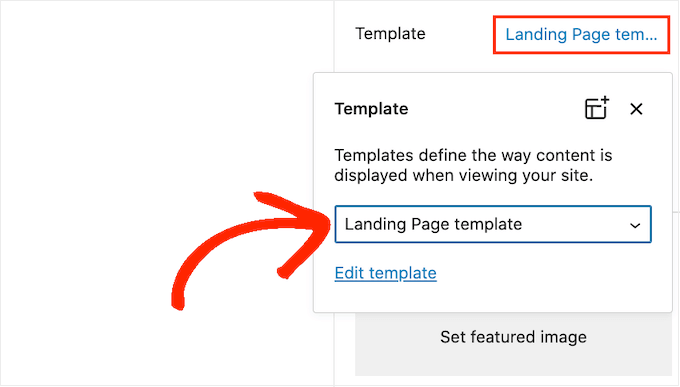
Po wykonaniu tej czynności można dodać treść do strony, tak jak w przypadku każdej innej strony WordPress.
Metoda 2. Jak utworzyć własną stronęza pomocą edytora całej witryny (tylko motywy blokowe)
Jeśli korzystasz z motywu opartego na blokach, możesz również utworzyć własną stronę za pomocą edytora całej witryny. Pozwala to na zmianę układu pojedynczej strony bez konieczności tworzenia własnego szablonu.
Mając to na uwadze, jest to dobry wybór, jeśli chcesz stworzyć całkowicie unikatowy projekt, którego nie wykorzystasz ponownie na żadnej innej stronie.
Aby rozpocząć, wystarczy utworzyć stronę w zwykły sposób, przechodząc do Strony “ Utwórz nową. Następnie możesz wpisać tytuł, dodać kategorie i tagi, przesłać obrazek wyróżniający i wprowadzić dowolne inne zmiany.
Kiedy będziesz zadowolony z wyglądu twojej strony, zapisz zmiany i przejdź do sekcji Wygląd “ Edytor.
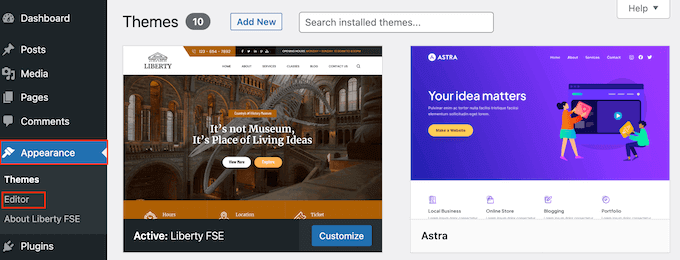
Domyślnie w pełnym edytorze witryny wyświetlany jest szablon główny twojego motywu.
W menu po lewej stronie kliknij “Strony”.
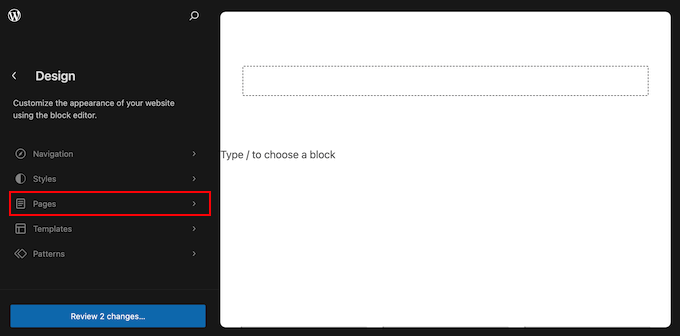
Zobaczysz teraz wszystkie strony, które utworzyłeś w swojej witrynie internetowej WordPress.
Po prostu znajdź stronę, którą chcesz przeprojektować i kliknij ją.
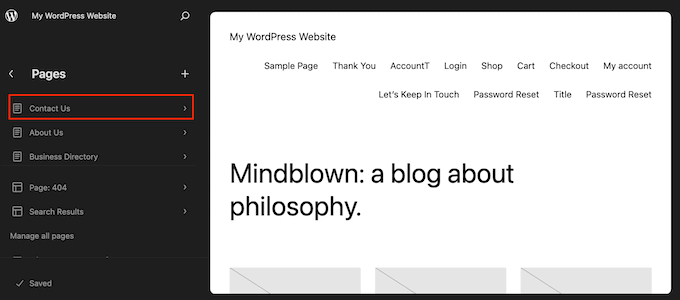
WordPress wyświetli teraz podgląd projektu.
Aby przejść dalej i edytować ten szablon, kliknij małą ikonkę ołówka.
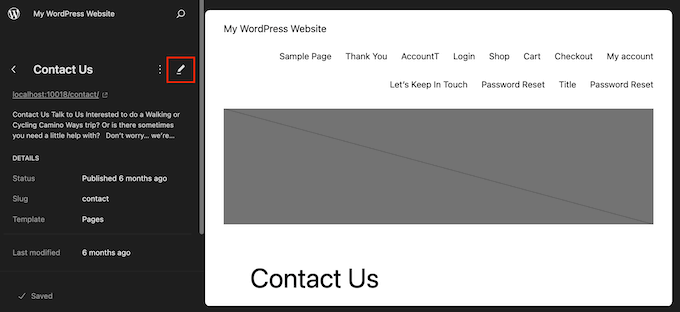
Możesz teraz edytować układ strony za pomocą narzędzi edytora na całej witrynie. Możesz na przykład kliknąć niebieski przycisk “+”, aby utworzyć nowe bloki, lub kliknąć, aby wybrać dowolny blok, który chcesz dostosować.
Gdy będziesz zadowolony z wprowadzonych zmian, kliknij przycisk “Zapisz”.
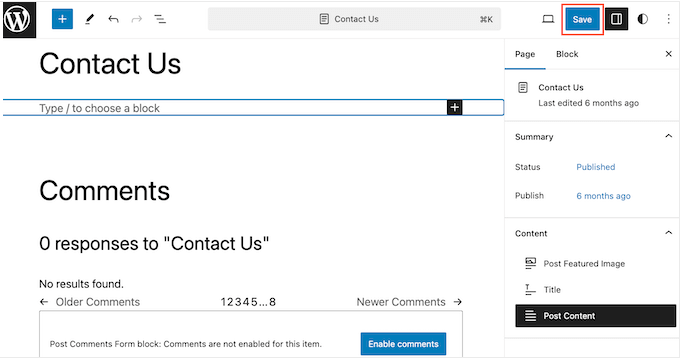
Teraz, jeśli przejdziesz na tę stronę w twojej witrynie internetowej, zobaczysz nowy wygląd strony w działaniu.
Metoda 3. Utwórz własną stronę w WordPress za pomocą SeedProd (zalecane)
W przeszłości tworzenie własnej strony polegało na pisaniu kodu, co nie było zbyt przyjazne dla początkujących. Jeśli popełniłeś błąd w kodzie HTML, CSS lub PHP, może to spowodować typowe błędy WordPressa lub nawet całkowicie zepsuć twoją witrynę.
Mając to na uwadze, zalecamy skorzystanie z kreatora stron.
SeedProd to najlepszy kreator stron typu “przeciągnij i upuść ” dla WordPress. Zawiera ponad 350 szablonów, umożliwiając tworzenie własnych stron bez pisania jakiegokolwiek kodu.
Jeśli korzystasz z niestandardowej strony, aby uzyskać więcej konwersji, SeedProd współpracuje z wieloma popularnymi narzędziami innych firm, których możesz już używać do uzyskiwania konwersji. Obejmuje to najlepsze usługi e-mail marketingu, WooCommerce, Google Analytics i inne.
Najpierw należy zainstalować i włączyć SeedProd. Aby uzyskać więcej informacji, zobacz nasz przewodnik krok po kroku, jak zainstalować wtyczkę WordPress.
Uwaga: Istnieje również darmowa wersja SeedProd, która umożliwia tworzenie własnych stron bez względu na twój budżet. Jednak na potrzeby tego przewodnika będziemy używać SeedProd Pro, ponieważ ma on o wiele więcej szablonów i integruje się ze wszystkimi najlepszymi usługami e-mail marketingu.
Po włączaniu wtyczki, SeedProd poprosi o twój klucz licencyjny.

Informacje te można znaleźć na Twoim koncie w witrynie internetowej SeedProd. Po wpiszeniu klucza kliknij przycisk “Zweryfikuj klucz”.
Wybór własnego szablonu strony
Gdy już to zrobisz, przejdź do SeedProd ” Landing Pages i kliknij przycisk “Utwórz nową stronę docelową”.
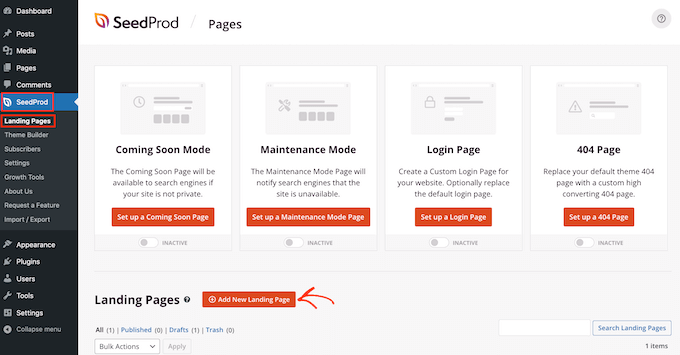
Możesz teraz wybrać szablon dla twojej własnej strony.
Szablony SeedProd są podzielone na różne typy kampanii, takie jak “lead”,“squeeze” i“coming soon“. Możesz kliknąć karty w górnej części ekranu, aby filtrować szablony na podstawie typu kampanii.
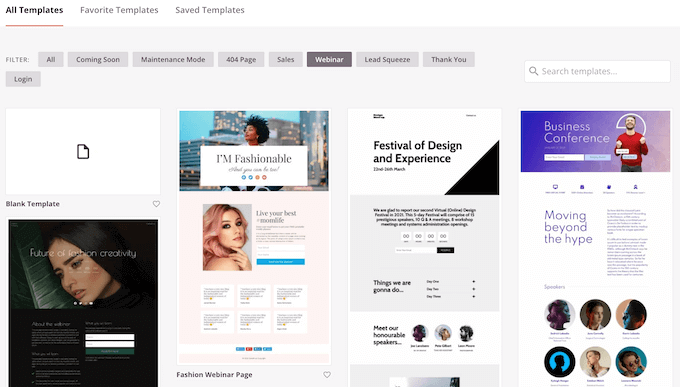
Jeśli chcesz zacząć od zera, SeedProd ma również pusty szablon, którego możesz użyć.
Aby przyjrzeć się bliżej dowolnemu szablonowi, po prostu najedź na niego kursorem myszy, a następnie kliknij ikonkę lupy.
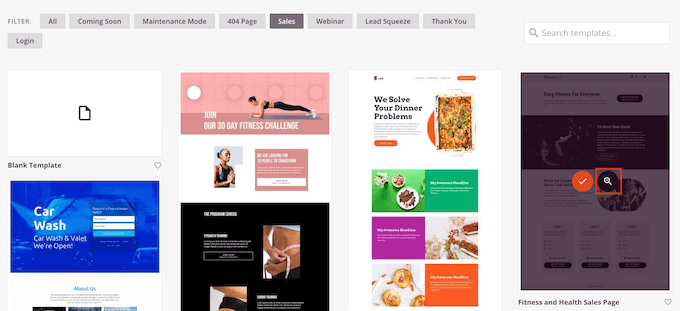
Gdy znajdziesz projekt, który Ci się podoba, kliknij “Wybierz ten szablon”. We wszystkich naszych obrazkach używamy szablonu “Course Sales Page”, ale możesz użyć dowolnego szablonu.
Następnie wpisz rodzaj nazwy dla własnej strony. SeedProd automatycznie utworzy adres URL na podstawie tytułu strony, ale możesz go zmienić na dowolny inny.
Opisowy adres URL pomoże również wyszukiwarkom zrozumieć, o czym jest strona, dzięki czemu będą mogły pokazać ją właściwym użytkownikom, co poprawi twoje SEO WordPress.
Aby dać twojemu konfiguratorowi najlepszą szansę na pojawienie się w odpowiednich wynikach wyszukiwania, możesz dodać słowa kluczowe, których brakuje w adresie URL. Aby uzyskać więcej informacji, zapoznaj się z naszym przewodnikiem na temat badania słów kluczowych.
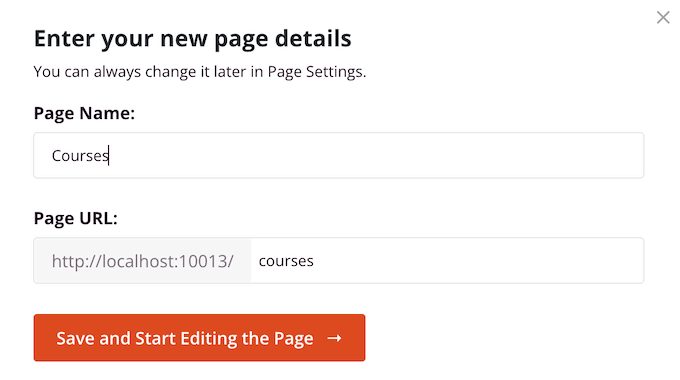
Gdy jesteś zadowolony z informacji, które wpiszesz, kliknij przycisk “Zapisz i rozpocznij edycję strony”.
Zaprojektuj swoją własną stronę
SeedProd otworzy teraz twój wybrany szablon w przyjaznym dla użytkownika edytorze przeciągnij i upuść. Po prawej stronie zobaczysz podgląd na żywo twojej strony, a po lewej niektóre ustawienia bloków.

Aby dostosować blok, wystarczy kliknąć, aby wybrać go w edytorze strony. Lewy pasek narzędzi pokaże wszystkie ustawienia dla tego bloku.
Na poniższym obrazku zmieniamy tekst wewnątrz bloku “Nagłówek”.
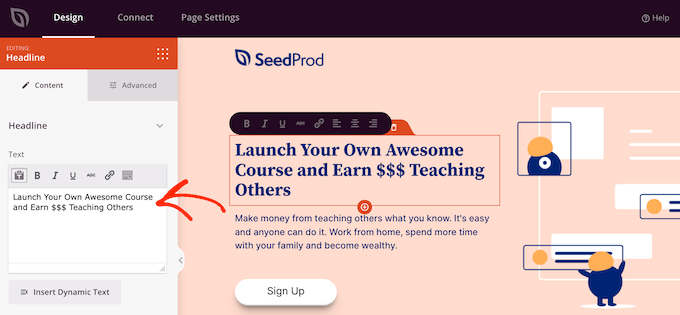
Możesz formatować tekst, zmieniać jego wyrównanie, dodawać odnośniki i nie tylko, korzystając z ustawień w menu po lewej stronie.
Łatwo jest również edytować obrazki za pomocą kreatora stron SeedProd. Wystarczy kliknąć dowolny blok “Obrazek” i użyć ustawień, aby dodać tekst alternatywny, utworzyć nowy obrazek lub wprowadzić inne zmiany.
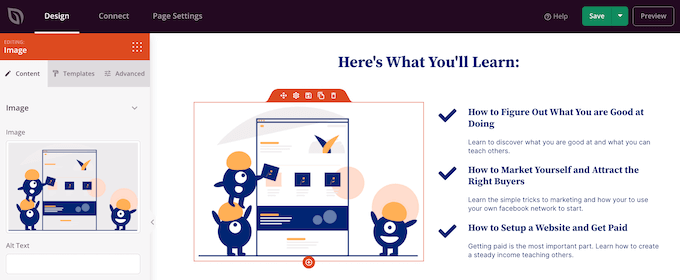
Jeśli chcesz usunąć blok z własnej strony, po prostu kliknij, aby wybrać ten blok.
Następnie kliknij ikonkę kosza na mini pasku narzędzi.
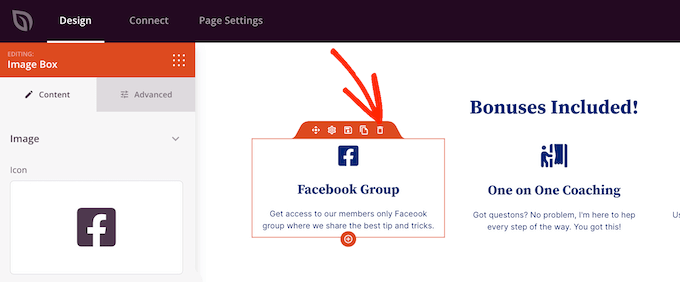
Aby utworzyć nowe bloki do twojego projektu, po prostu znajdź blok w menu po lewej stronie, a następnie przeciągnij go do edytora.
Następnie możesz kliknąć, aby wybrać blok i wprowadzić zmiany w menu po lewej stronie.
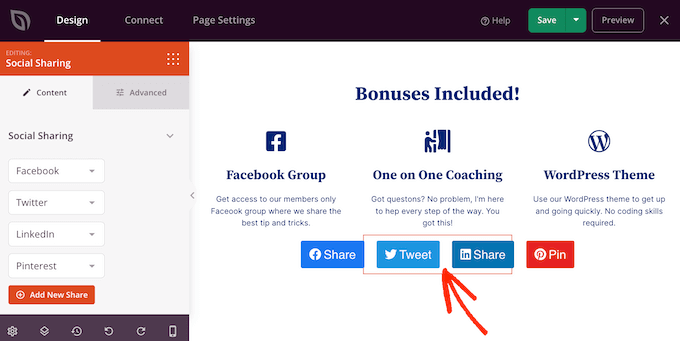
SeedProd zawiera również “Sekcje”, które są szablonami wierszy i bloków, które mogą pomóc w szybkim utworzeniu własnej strony. Na przykład, jeśli projektujesz stronę docelową Google Ad, możesz użyć gotowych sekcji Hero, Call To Action lub funkcji SeedProd.
Aby zobaczyć wszystkie dostępne sekcje, wystarczy kliknąć kartę “Sekcje”.
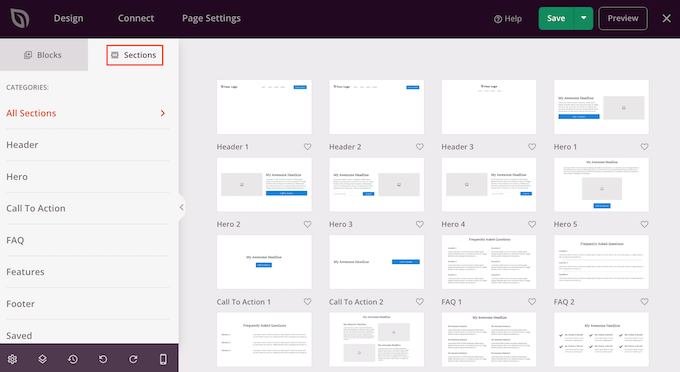
Aby dokładniej przyjrzeć się danej sekcji, najedź na nią kursorem myszy, a następnie kliknij ikonkę lupy.
Gdy znajdziesz sekcję, którą chcesz dodać do twojego projektu, po prostu najedź na nią myszką, a następnie kliknij małą ikonkę “+”.
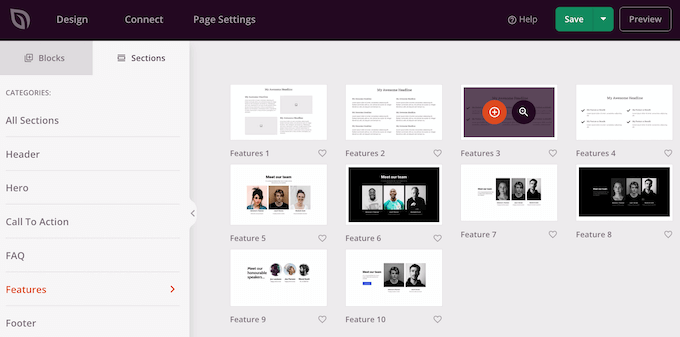
Spowoduje to dodanie sekcji na dole twojej strony. Możesz przenosić zarówno sekcje, jak i bloki wokół twojego projektu za pomocą przeciągania i upuszczania.
Jeśli popełnisz błąd lub zmienisz zdanie, nie martw się. Możesz cofnąć twoją ostatnią zmianę, klikając przycisk “Cofnij” u dołu lewego paska narzędzi.
Znajdziesz tu również przycisk ponawiania, historię wersji, nawigację po układzie i ustawienia globalne.
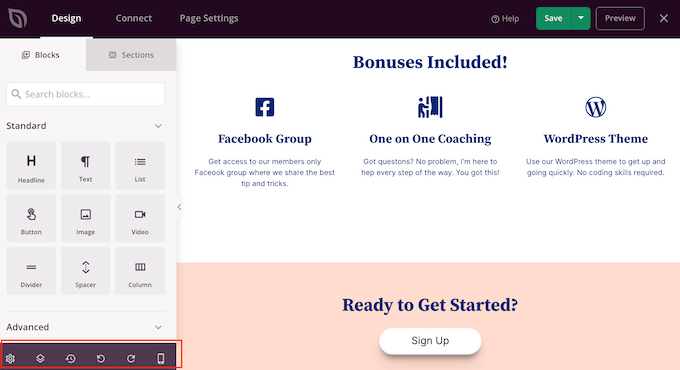
Te dodatkowe przyciski ułatwiają tworzenie własnych stron w WordPress.
W dolnej części paska narzędzi znajduje się również przycisk podglądu mobilnego, który pozwala zobaczyć mobilną wersję dostosowanej strony.
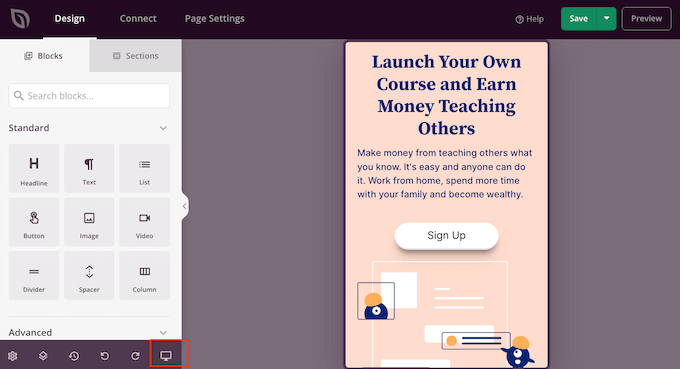
Może to pomóc w zaprojektowaniu własnej strony, która wygląda równie dobrze na urządzeniach mobilnych, jak i na twoim komputerze.
Kiedy jesteś zadowolony z własnego konfiguratora, nadszedł czas, aby go opublikować, klikając strzałkę rozwijaną obok “Zapisz”, a następnie wybierając opcję “Opublikuj”.
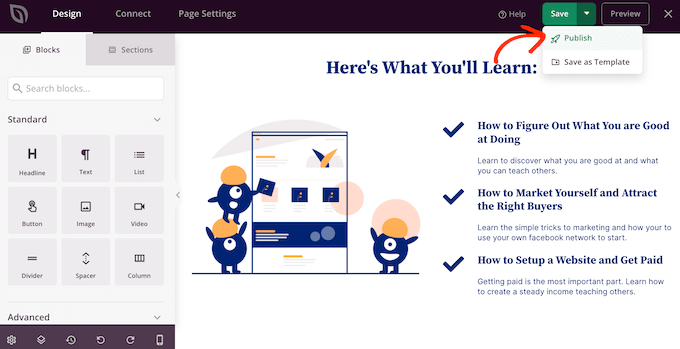
Twoja niestandardowa strona zostanie teraz uruchomiona na Twoim blogu WordPress.
Jeśli chcesz edytować własną stronę w dowolnym momencie, po prostu przejdź do SeedProd ” Landing Pages w Twoim kokpicie WordPress. Następnie znajdź stronę, którą chcesz zmienić i kliknij odnośnik “Edytuj”.
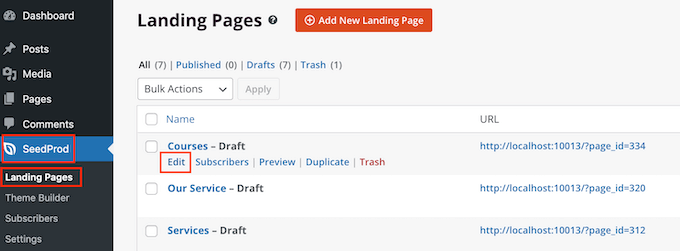
Spowoduje to otwarcie projektu w edytorze SeedProd, gotowego do wprowadzenia twoich zmian.
Metoda 4. Użycie Thrive Architect do stworzenia własnej strony w WordPressie
Możesz również utworzyć własną stronę za pomocą Thrive Architect. Thrive Architect to kolejny popularny kreator stron typu “przeciągnij i upuść” dla WordPress.
Zawiera ponad 300 profesjonalnie zaprojektowanych szablonów, które mają pomóc w uzyskaniu większej liczby konwersji.

Najpierw należy zainstalować i włączyć wtyczkę Thrive Architect. Aby uzyskać więcej informacji, zapoznaj się z naszym przewodnikiem krok po kroku, jak zainstalować wtyczkę WordPress.
Po włączeniu, przejdź do Pages ” Add New w kokpicie administracyjnym WordPress, aby utworzyć konfigurator własnej strony. Następnie kliknij przycisk “Launch Thrive Architect”.
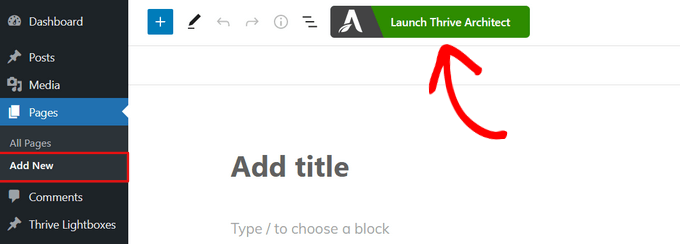
Następnie możesz wybrać, czy chcesz utworzyć normalną stronę, czy gotową stronę docelową.
Zalecamy kliknięcie na “Pre-built Landing Page”, ponieważ daje to dostęp do wszystkich szablonów stron docelowych Thrive. Szablony te są w pełni konfigurowalne, więc możesz je dostosować do swojej witryny WordPress.
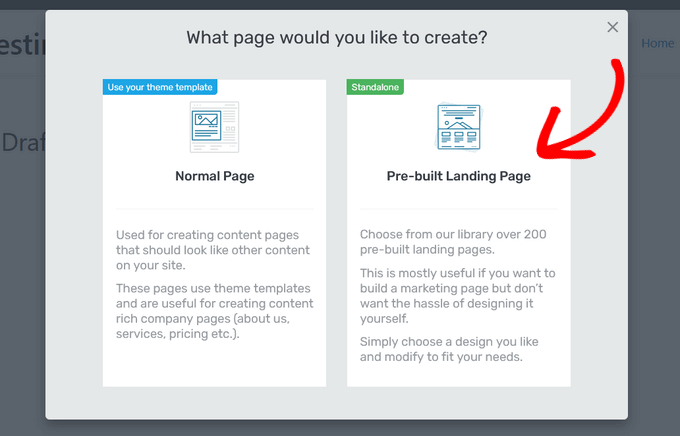
Gdy znajdziesz zestaw, który Ci się podoba, po prostu kliknij, aby go wybrać.
Na poniższym obrazku wybieramy “Inteligentne zestawy stron docelowych”.
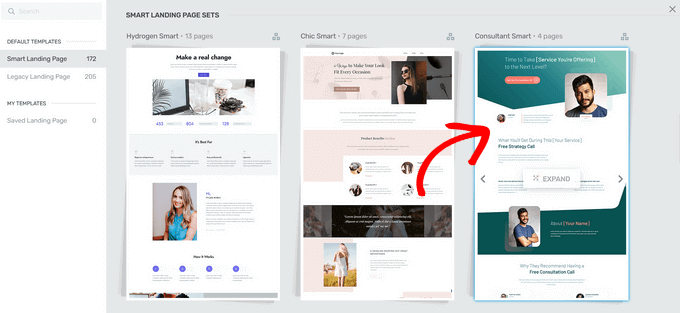
Na kolejnym ekranie należy wybrać konkretny szablon z zestawu.
Wybierz szablon, klikając go, a następnie naciskając przycisk “Zastosuj szablon”.
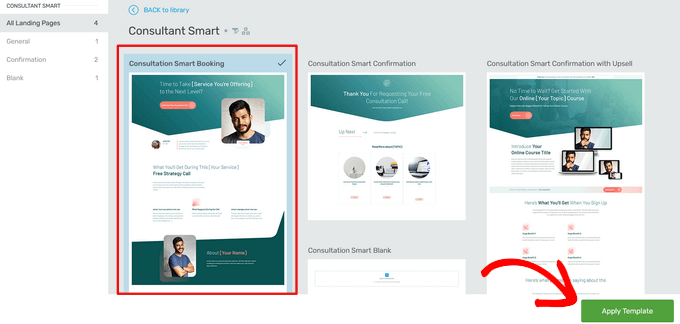
Spowoduje to otwarcie szablonu w edytorze Thrive Architect. Stąd możesz łatwo dostosować szablon strony do twojego bloga, witryny internetowej lub sklepu internetowego.
Na przykład, można zmienić “Nagłówek” klikając na niego, a następnie wpisując Twój własny, dostosowany komunikat.
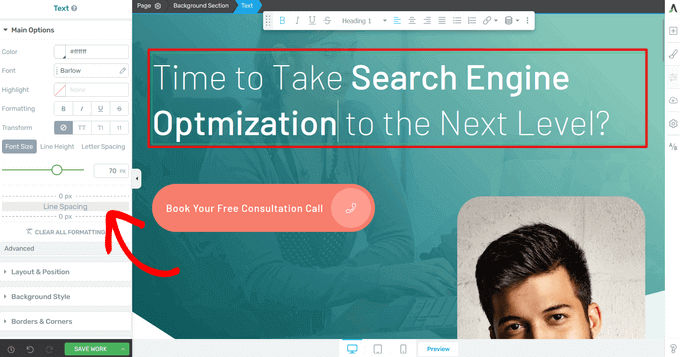
W menu po lewej stronie zobaczysz teraz wszystkie opcje konfiguratora. Tutaj możesz zmienić typografię, wielkość liter, kolor, formatowanie i wiele więcej.
W panelu po lewej stronie można również dostosować inne ustawienia własnej strony, takie jak układ, styl tła, obramowania, animacje i zachowanie przewijania, by wymienić tylko kilka z nich.
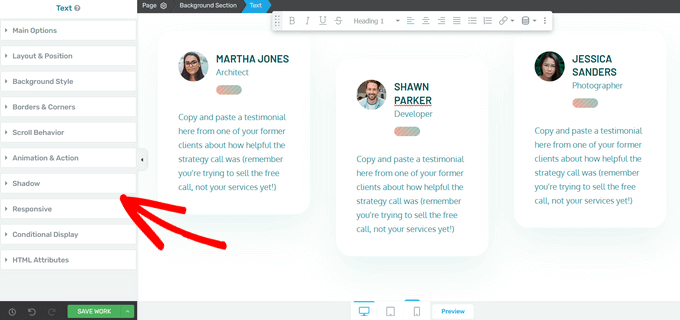
Podobnie jak bloki SeedProd, Thrive Architect zawiera wiele gotowych elementów, które możesz dodać do swojego konfiguratora.
Aby utworzyć nowy element na stronie, kliknij przycisk “Dodaj element (+)” po prawej stronie ekranu.
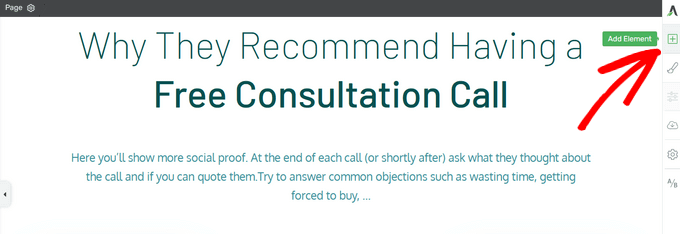
Możesz teraz wybierać spośród takich elementów jak obrazy, przyciski, formularze generowania leadów, tabele cenowe, liczniki czasu i inne.
Aby dodać element, wystarczy przeciągnąć go z menu po prawej stronie i upuścić na twojej stronie.
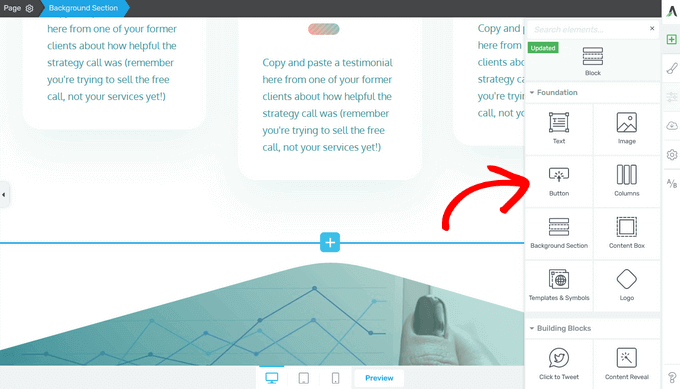
Ponownie, możesz edytować każdy z nowych elementów, które utworzysz na swojej stronie, klikając je.
Kiedy będziesz zadowolony z wyglądu strony, kliknij przycisk strzałki (^) obok przycisku “Zapisz pracę”. Następnie kliknij opcję “Zapisz i wróć do edytora wpisów”.
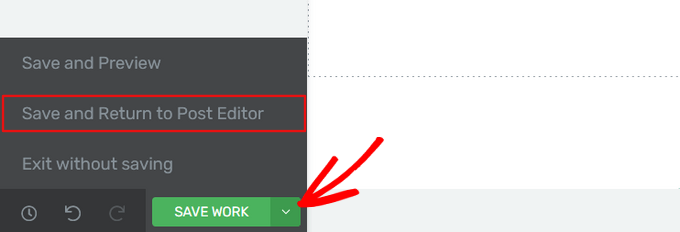
Następnie możesz zapisać stronę jako wersję roboczą lub opublikować ją, aby pojawiła się na twojej witrynie internetowej WordPress.
Po opublikowaniu twojego konfiguratora możesz przejść na twoją witrynę, aby zobaczyć go w działaniu.
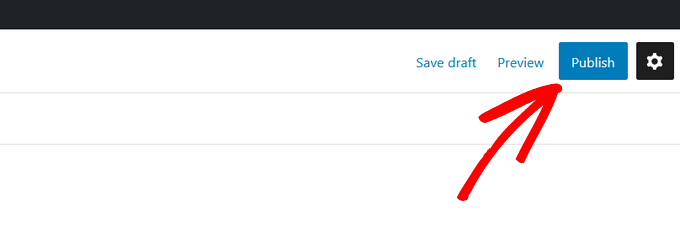
Mamy nadzieję, że ten artykuł pomógł ci dowiedzieć się, jak utworzyć niestandardową stronę w WordPress. Możesz również zapoznać się z naszym przewodnikiem na temat tworzenia strony docelowej w WordPress i dzielenia tytułu postu lub strony w WordPress.
If you liked this article, then please subscribe to our YouTube Channel for WordPress video tutorials. You can also find us on Twitter and Facebook.





Hemant Kuswah
Hiii, Thanks for the information.
I have a little problem/confusion. I had made the custom page as you described in the tutorial above. But i want to add custom php code to fetch data from other place and display on the custom page i just created.
There will be a dropdown on the custom page and on selecting a value it will display some data on the same page which is either coming from database or from some other website.
How can i do that ?
Any suggestion ?
?
Thanks
Jared
Hi – I was wondering how I can avoid including other plugins css and js files such as woocommerce and various others in my template.
Thanks,
J.
Valerio
What if the theme has a kind of wrapper base.php? I would like to create a new custom page template but I always get also what is in the main wrapper base.php. Did I make myself clear enough?
Dre
how about this one,
I want the sidebar on the very right and all the other content “full width” on the page. How can I do this?
When I choose “Full Width” in the WordPress-Site-Settings, the sidebar of course is gone and my content still isn’t full width.
you can see my page here:
thank you!
Yazhini
How to make FTP client connection?
WPBeginner Support
Hey Yazhini,
You will need to enter your website domain, FTP username and password. For detailed instructions please see our guide on How to use FTP to upload files to WordPress.
Admin
Yiani
Nothing shows up in the drop down in Page Attributes? I am using Storefront theme for Woocommerce. What is the solution? Is Storefront not allowing custom page templates? Any help is much appreciated. Thanks.
Henry
Very educative indeed, thanks alot. However, I have a rather unique situation and after reading your post felt I should ask. I have two lovely pages I long to add to my wordpress theme, but sadly they are static HTML pages with commenting, voting as well as sharing system. Is there a way I can get them into my existing wordpress theme and also get them to use the wordpress commenting, voting and sharing systems?
Ketan Chaudhari
Thank you for this tutorial.
Today, You give me a chance to learn something new in wordpress.
Natacha
Thank you for the tutorial. I am happy to learn new stuff step by step.
But, When I preview the page with the new template, I don’t have a white page, I have my default theme loaded.
How can I change that?
WPBeginner Support
Hi Natacha,
You can click on Appearance and then select a theme. See our guide on how to install a WordPress theme for detailed instructions.
Admin
Natacha
Thank you for the answer.
But, I cannot change the theme of my whole website. I just needed to create a blank page so I can create a forum.
Hero
Instead of reinventing the wheel, why not just use BuddyPress?
Tim
I just want to THANK YOU for posting this. I’ve been trying to get a static front page to work with my custom template and I just couldn’t find a straight and simple answer until stumbling upon this article. Much appreciated.
WPBeginner Support
Hi Tim,
You are welcome Don’t forget to follow us on Facebook for more WordPress tips and tutorials.
Don’t forget to follow us on Facebook for more WordPress tips and tutorials.
Admin
hamed ahmed
thanks, the google search console requires to save .html file to my wordpress website , but .html will not be appeared in the website , can any one help please because i want to register my website to search console
WPBeginner Support
Hi Hamed,
You can also verify by adding the meta tag or by using Yoast SEO plugin which allows you to add the meta tag from its settings page.
Admin
Sameer Kumar
how to remove sidebar Php?
KH
I don’t see the template option in the Page Attributes section of my wp page – is there something I need to do to see this?
Yasser
thanks alot.
It worked perfectly.
Luis
Thanks for the post! It was so difficult to find this simple answer in the wordpress codex. One suggestion, though. Please add to your post that when users create their ‘custom_page.php’ file to add a header tag, i.e. with a text title so they don’t get a white page on the first go. It’s just a quick way of making sure the page is really working. Again, thanks a lot for making this so easy!
ashkan 261
So cool thank a lot dear
AltisB
I m trying to embed some javascipt or html codes into the blank page… how should i do that? Because i now have the blank page but when i embed the embedded codes onto the editor it doesnt seems to work.
kray
How do you do this for WordPress 4.7? No Template shows up when I attempt to create a page in 4.7.
Altisb
“Once you have added the code, save the file to your desktop as, custompaget1.php.”
My notepad save the file as .txt
How to you even save it as .php file???
WPBeginner Support
Hello,
Try using ‘Save as’ instead of save option from the file menu. When using save as write full name for your file. You can also rename the existing custompaget1.php.txt file to custompaget1.php
Admin
Ben
I’m truly a beginner and found the steps easy to follow. I created my new .php file following the instructions, pasting the page.php text at the end of my new .php file. I’m to the point where my new custom page template is available in the drop down when I create a new page. I select the new template for the new page, and when I make changes to the new page in the customizer (delete a text widget from the sidebar), the changes are applied to the other pages that have the default template selected as well, not to just my new page with the new custom template selected. Any ideas?
Marshall
I found this really helpful. However, I did have one problem. When I go to the new page
there is a 32px top margin on it which does not show on the other page.
Logan
Hello,
I have an issue with my WP pages. I have a website up and running and I recently needed to add a new page and a new menu button. I’ve made a new menu button and created a new page (default template) and published it. However, on the website, after clicking on the new button under which this new page should be, it’s only showing header and footer. Not my new page.
Could you be so kind and advise me on this? I’m a total WP beginner so building my own template page is out of the question and I was under the impression that simply adding a new page to my WP website should be only a few clicks away…
Thanks
WPBeginner Support
Hi Logan,
Please check out our guide on adding navigation menus in WordPress.
Admin
Anish
Hi! I did as you said.
I created a .php file with the same code snippet as given and uploaded it onto my /wp-content/themes folder. Now, when i go to the Page section on WordPress, there is no option for the Template choosing. What should i do ? Can you figure out where i might be going wrong ?
Leonardo
Hi. I don’t know any php and I need to creature a custom page for my website.
Is it possible to create an HTML page from scratch, include javascript to the page and put it into the .php file as described?
Thanks.
WPBeginner Support
Hi Leonardo,
You will still need to use PHP for WordPress template tags.
Admin
Mo
@DAN Are you sure that you including the header. Thats usually where WP will enqueue your style.css
Dan
Hi,
I’m trying to create a blank template to be used for a landing page. I succeded in creating the blank template, but now when I try to add content (using the WP editor or Visual Composer or even a CF7 contact form) no style is applied. Is there any way to tell the template to use the theme css style?
Thanks
Marco Milano
This isn’t a new post type but is a new template. They’re two different thing. In fact the you can call a template from a post whereas the custom post type has a personal space in admin panel.
Julie
I followed all the steps and they worked until I tried to select it in the “Page Attributes” part. The “CustomPageT1” is just not an option in the drop down menu!
What can I do so that WordPress and or my theme can pick up that it’s a template?
Thanks in advance!
Julie
WPBeginner Support
Most often users make mistake while copy-pasting code snippets. Please make sure that your custom template file contains exactly the same code
<?php /* Template Name: CustomPageT1 */ ?>Admin
Ubaid
I want to add a full width header image before entire content and sidebar. How can I do that?
Girija Tandel
Thank you so muc for this wonderfull tutorial.
This helps me a lot.
It works great.
Harish S Reddy
Thank You , it works Great !
WPBeginner Support
Hey Harish, glad you found it helpful. Don’t forget to follow us on Facebook for more WordPress tips and tutorials.
Admin
Charmy Dexter
It was like I’m reading 123. I hope a page template of a theme could be used in another theme.
Uchenna
please can you help me out. I have two themes. one for my desktop view and the other for mobile. i used any mobile switcher to get the mobile view working. I designed a static page for desktop theme and this is where my problem begins because once i set from “reading” to use static front page for the desktop theme, the mobile theme homepage stops displaying posts. please is there a way i can get this working? this is the site am talking about thanks in advnce
Matthew
Way easier than I thought this would be. Thank you!
Rahul Tiwari
Hi,
Its really helpful for me and very easy to understand.
Thanks
jass
thank you very much.This article really helps
Steven Denger
For a “beginner” this was not helpful. You did not explain the steps more in detail, like “go to your current theme folder” – how do I do this? And your FTP instructions were way to vague. If I was able to understand your instructions I wouldn’t have needed this wp-beginner in the first place as it is explained for those that have mor tech experience.
These tutorals were not at all helpful and are just targeted for the more tech viewers.
NO HELP HERE AT ALL!!
WPBeginner Support
Hi Steven,
We are sorry that you didn’t find this article helpful. We will try to explain in comments.
To connect to your theme folder you will need an FTP client. These are special software which allow you to connect to your webserver and upload, delete, and manage your files directly.
When you sign up with a WordPress hosting provider, they send you an email with your FTP login credentials. If you did not receive this email then please contact your hosting provider via chat or email and then will send them to you right away.
However, if using FTP seems a bit too difficult, then you can also use File Manager. It is a web based application available under your web hosting account. Login to your web hosting account and look for File Manager.
Let us know if you need more help
We will try to improve and make our articles even more beginner friendly in the future.
Admin
Niki
Many thank you for simple and informative article helped me to start
Chibuike Mba
Thank you very much, this your article about custom page have really pointed me in the right direction for I needed to override theme page in my plugin for some custom post types.
Thank you once again.
WPBeginner Support
We are glad you found it helpful:) Don’t forget to follow us on Twitter for more WordPress tips and tutorials.
Admin
Wayne from Keys English
Hello,
What can I do if I see the successful transfer of the custompageT1 to my FireFTP client, but when I go into WP admin – create a new page – scroll down to template, the custompageT1 is not in the drop down list to select?
Thanks
Wayne
zamaan
Excellent, very useful. Thank you.
but u fogot to tell where i want to add my custom php code in the template file
Jaczkowski
I learnt something new. Thanks alot
Janet Fuller
This is really extra ordinary. Generally, I do add a page and then create that. But today, I have known something new.
nevenx
Hi,
is it possible to integrate another script to wp (e.g. faucetbox script) on this way?
WPBeginner Support
You can, but it would be better to create a plugin for that.
Admin
San
Great article. Helps to ease my confusion
Tak
thanks for the very concise tutorial with simple examples. it was super easy to follow!
Radhakrishnan
Dear sir,
I did what you say. but in my page edit screetn there no template comming in attribute. what i can do sir?
levan
many thanks to you my dear its very helpful
Gabriel
This is a great tutorial. Very simple and easy to follow. Thank you!
Waleed Barakat
Thanks for the tutorial! actually i have a games WordPress template and every time i try to create a page treat it as a game and not show the page content as usual, but i think everything will be okay after reading and applying this tutorial on my website:
Thanks again